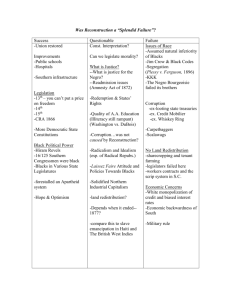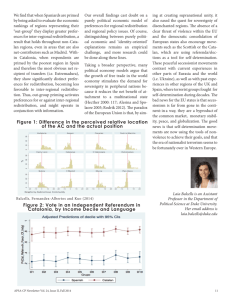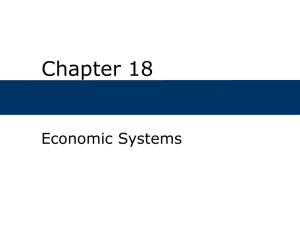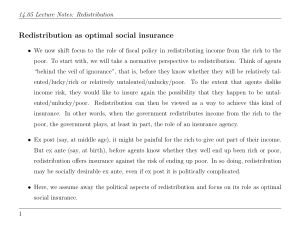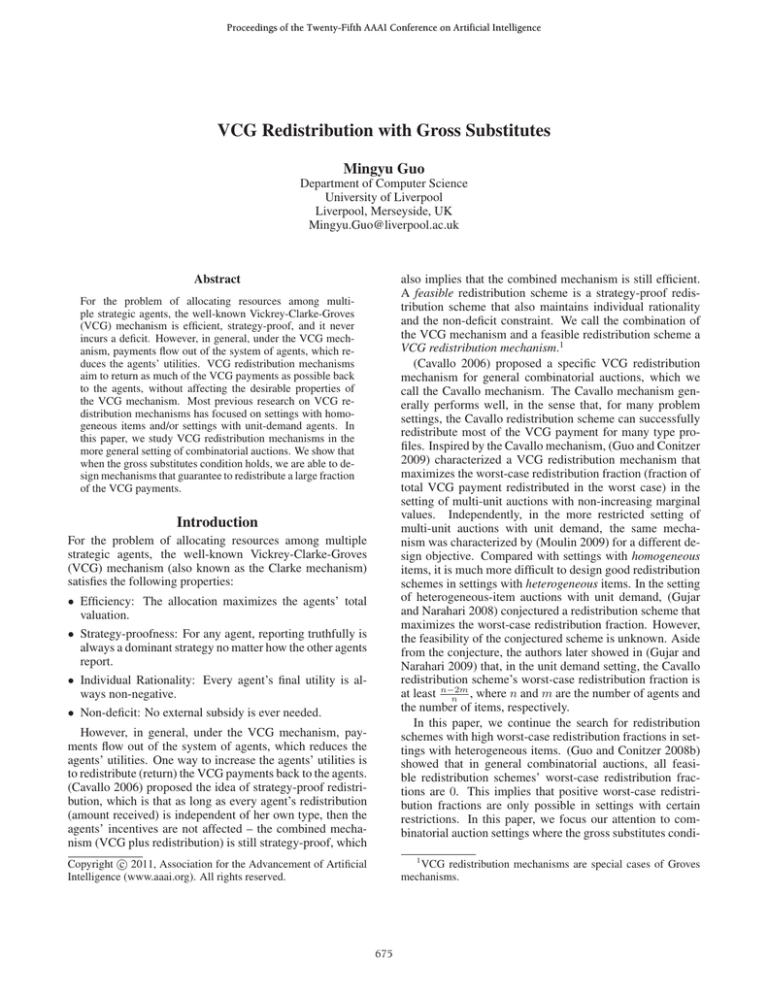
Proceedings of the Twenty-Fifth AAAI Conference on Artificial Intelligence
VCG Redistribution with Gross Substitutes
Mingyu Guo
Department of Computer Science
University of Liverpool
Liverpool, Merseyside, UK
Mingyu.Guo@liverpool.ac.uk
also implies that the combined mechanism is still efficient.
A feasible redistribution scheme is a strategy-proof redistribution scheme that also maintains individual rationality
and the non-deficit constraint. We call the combination of
the VCG mechanism and a feasible redistribution scheme a
VCG redistribution mechanism.1
(Cavallo 2006) proposed a specific VCG redistribution
mechanism for general combinatorial auctions, which we
call the Cavallo mechanism. The Cavallo mechanism generally performs well, in the sense that, for many problem
settings, the Cavallo redistribution scheme can successfully
redistribute most of the VCG payment for many type profiles. Inspired by the Cavallo mechanism, (Guo and Conitzer
2009) characterized a VCG redistribution mechanism that
maximizes the worst-case redistribution fraction (fraction of
total VCG payment redistributed in the worst case) in the
setting of multi-unit auctions with non-increasing marginal
values. Independently, in the more restricted setting of
multi-unit auctions with unit demand, the same mechanism was characterized by (Moulin 2009) for a different design objective. Compared with settings with homogeneous
items, it is much more difficult to design good redistribution
schemes in settings with heterogeneous items. In the setting
of heterogeneous-item auctions with unit demand, (Gujar
and Narahari 2008) conjectured a redistribution scheme that
maximizes the worst-case redistribution fraction. However,
the feasibility of the conjectured scheme is unknown. Aside
from the conjecture, the authors later showed in (Gujar and
Narahari 2009) that, in the unit demand setting, the Cavallo
redistribution scheme’s worst-case redistribution fraction is
at least n−2m
n , where n and m are the number of agents and
the number of items, respectively.
In this paper, we continue the search for redistribution
schemes with high worst-case redistribution fractions in settings with heterogeneous items. (Guo and Conitzer 2008b)
showed that in general combinatorial auctions, all feasible redistribution schemes’ worst-case redistribution fractions are 0. This implies that positive worst-case redistribution fractions are only possible in settings with certain
restrictions. In this paper, we focus our attention to combinatorial auction settings where the gross substitutes condi-
Abstract
For the problem of allocating resources among multiple strategic agents, the well-known Vickrey-Clarke-Groves
(VCG) mechanism is efficient, strategy-proof, and it never
incurs a deficit. However, in general, under the VCG mechanism, payments flow out of the system of agents, which reduces the agents’ utilities. VCG redistribution mechanisms
aim to return as much of the VCG payments as possible back
to the agents, without affecting the desirable properties of
the VCG mechanism. Most previous research on VCG redistribution mechanisms has focused on settings with homogeneous items and/or settings with unit-demand agents. In
this paper, we study VCG redistribution mechanisms in the
more general setting of combinatorial auctions. We show that
when the gross substitutes condition holds, we are able to design mechanisms that guarantee to redistribute a large fraction
of the VCG payments.
Introduction
For the problem of allocating resources among multiple
strategic agents, the well-known Vickrey-Clarke-Groves
(VCG) mechanism (also known as the Clarke mechanism)
satisfies the following properties:
• Efficiency: The allocation maximizes the agents’ total
valuation.
• Strategy-proofness: For any agent, reporting truthfully is
always a dominant strategy no matter how the other agents
report.
• Individual Rationality: Every agent’s final utility is always non-negative.
• Non-deficit: No external subsidy is ever needed.
However, in general, under the VCG mechanism, payments flow out of the system of agents, which reduces the
agents’ utilities. One way to increase the agents’ utilities is
to redistribute (return) the VCG payments back to the agents.
(Cavallo 2006) proposed the idea of strategy-proof redistribution, which is that as long as every agent’s redistribution
(amount received) is independent of her own type, then the
agents’ incentives are not affected – the combined mechanism (VCG plus redistribution) is still strategy-proof, which
c 2011, Association for the Advancement of Artificial
Copyright Intelligence (www.aaai.org). All rights reserved.
1
VCG redistribution mechanisms are special cases of Groves
mechanisms.
675
won by agent
ni. An efficient allocation is an allocation that
maximizes i=1 vi (Bi ) (total valuation). Similarly, when
we only consider a subset of agents S (removing the other
agents from the auction), then an allocation of the items to
the agents in S correspond to |S| disjoint bundles, where Bi
is the bundle won by agent i for i ∈ S. An efficient allocation of the items
to the agents in S is then an allocation that
maximizes i∈S vi (Bi ). We use U (S) to denote the total
valuation of the agents in S when we allocate the items to
them efficiently.
To avoid dealing with tie-breaking, we assume that the set
of possible type profiles contains only those that are tie-free:
for any set of agents S, the efficient allocation of the items
to the agents in S is unique.5
The VCG mechanism allocates the items to the agents efficiently. If an agent does not win anything, then she pays
nothing. If an agent wins something, then she pays “how
much she hurts the other agents as a result of her presence”.
Let X be the set of winners when we allocate the items to
all the agents efficiently. For every winner i ∈ X, we denote
her bundle by Bi . Winner i’s VCG payment is defined to be
VCG payment is
U (I − i) − (U (I) − vi (Bi )).6 The total
(I)+v
(B
))
=
then i∈X (U (I −i)−U
i
i
i∈X (U (I −i)−
U (I))+U (I) = i∈X U (I −i)−(|X|−1)U (I). Since removing a loser does not change U (I),
we have that the total
VCG payment
can
also
be
written
as
i∈X U (I−i)−(|X|−
1)U
(I)
=
U
(I
−i)+(n−|X|)U
(I)−(n−1)U (I) =
i∈X
U
(I
−
i)
−
(n
−
1)U
(I).
We
use
V CG(I) to denote
i∈I
the total VCG payment when every agent participates in the
auction. Similarly, we use V CG(S) to denote the total VCG
payment when we use the VCG mechanism to allocate the
items to only the agents in S.
Our objective is to design a feasible redistribution scheme
that always redistributes a large fraction of the total VCG
payment even in the worst case.
tion (Kelso and Crawford 1982) holds. For the objective
of maximizing worst-case redistribution fraction, the setting studied in this paper is the most general so far.2 (Both
multi-unit auctions with non-increasing marginal values and
heterogeneous-item auctions with unit demand are special
cases of combinatorial auctions with gross substitutes condition.) We first show that in combinatorial auctions with
gross substitutes condition, the Cavallo mechanism’s worst. Since our recase redistribution fraction is exactly n−m−1
n
sult is derived in a more general setting, it actually implies
that in the more restricted setting of heterogeneous-item auctions with unit demand, the Cavallo mechanism’s worst-case
. That is, the
redistribution fraction is also exactly n−m−1
n
n−2m
lower bound n derived earlier in (Gujar and Narahari
2009) is now known to be not strict. Incidentally, our result also implies that in combinatorial auctions with gross
substitutes condition, when n = m + 2, the Cavallo mechanism is worst-case optimal among all VCG redistribution
mechanisms.3 Then, with the help of automated mechanism
design, we solve for redistribution schemes that significantly
outperform the Cavallo redistribution scheme in cases where
n is much larger than m. For example, when there are 50
agents and 2 items, we find a redistribution scheme whose
worst-case redistribution fraction is around 0.999999, while
the Cavallo redistribution scheme’s worst-case redistribution
fraction is only 0.94 (the worst-case fractions of waste differ
by several magnitudes).
Problem Description
There are n agents (I = {1, 2, . . . , n}) and m (m > 1)
heterogeneous items (J = {1, 2, . . . , m}). We only consider
cases where n > m + 1.4
An agent has different valuations for different bundles of
items. We use vi (B) to denote agent i’s valuation for winning bundle B. We assume that vi (∅) = 0 for all i. We
further assume free disposal: for any B ⊇ B and any i, we
have vi (B) ≥ vi (B ). An agent’s utility equals her valuation minus her payment.
An allocation of the items to the agents correspond to
n disjoint bundles B1 , B2 , . . . , Bn , where Bi is the bundle
Gross Substitutes
(Guo and Conitzer 2008b) showed that in general combinatorial auctions, when there are at least two items and at least
three agents, the worst-case redistribution fraction of any
feasible redistribution scheme is 0. Despite this negative result, we are able to achieve positive worst-case redistribution
fraction in more restricted settings. (Guo and Conitzer 2009)
and (Gujar and Narahari 2009) are two examples. These
two papers studied multi-unit auctions with non-increasing
marginal values and heterogeneous-item auctions with unit
2
Aside from the objective of this paper, other objectives have
also been studied (Guo and Conitzer 2008a; de Clippel, Naroditskiy, and Greenwald 2009; Guo and Conitzer 2010b; 2008b;
Apt et al. 2008). Most of the proposed mechanisms are only defined for settings with homogeneous items. One exception is (Guo
and Conitzer 2008b), which gives two numerical algorithms for
finding undominated redistribution schemes in general combinatorial auctions. Both numerical algorithms are based on discretization of the agents’ type spaces, which makes these two algorithms
inapplicable to the worst-case objective discussed in this paper.
3
(Guo and Conitzer 2009) showed that even in the more restricted setting of multi-unit auctions with unit demand, no feasible redistribution scheme’s worst-case redistribution fraction can
when n = m + 2.
be more than n−m−1
n
4
(Guo and Conitzer 2009) showed that in multi-unit auctions
with non-increasing marginal values, when n <= m + 1, the original VCG mechanism is worst-case optimal. Since the setting studied in this paper is more general, we have that in our setting, when
n <= m + 1, VCG is still worst-case optimal.
5
We cannot simply assume that a consistent tie-breaking rule
exists, because we need the tie-breaking rule to satisfy Proposition 2, which is that, winners still win after we remove some other
agents. Our conjecture is that such a tie-breaking rule exists, but
we do not know how to construct one (without additional technical
assumptions). Alternatively, we could drop this tie-free assumption. We allow all possible type profiles, but when we redistribute,
we perturb any type profile that is not tie-free infinitesimally so that
it becomes tie-free. This way we avoid dealing with tie-breaking,
but certain mechanism properties may be violated infinitesimally
due to perturbation.
6
I − i is short for I − {i}.
676
1)U (S) ≥ j∈S−i U (S−i−j)−(|S|−1)U (S−i). According to submodularity in agents, we have for any j ∈ S − i,
U (S − j) − U (S) ≥
U (S − i − j) −
U (S − i). That is,
U
(S
−
j)
−
U
(S)
≥
j∈S−i
j∈S−i j∈S−i U (S − i −
j) − j∈S−i U (S − i). That is, j∈S−i U (S − j) − (|S| −
1)U (S) ≥ j∈S−i U (S − i − j) − (|S| − 1)U (S − i).
demand, respectively. In this paper, we show that positive
worst-case redistribution fraction is achievable in a more
general setting — combinatorial auctions with gross substitutes condition.
The gross substitutes condition was first proposed in
(Kelso and Crawford 1982). For completeness, we include
its definition below. The terminology and notation are due
to (Lehmann, Lehmann, and Nisan 2003).
We associate each item with a price. Under price vector p = (p1 , p2 , . . . , pm ), item j is priced at pj . Agent
i’s surplus
of winning bundle B under price vector p is
vi (B) − j∈B pj . Agent i’s preferred bundles under p are
the bundles that maximize her surplus.
Proposition 2. Let S be any set of agents. Given that the
gross substitutes condition holds, if an agent i ∈ S is a winner when we allocate the items to the agents in S according
to the VCG mechanism, then for any S ⊂ S with i ∈ S , i
is still a winner when we allocate the items to the agents in
S according to the VCG mechanism.
Definition 1. Agent i’s type satisfies the gross substitutes
condition if for any item j, any two price vectors p and q,
with q ≥ p (element-wise comparison) and pj = qj , we
have that if item j is in a preferred bundle of agent i under
p, then there exists a preferred bundle of agent i under q that
also contains item j.
The above proposition says that a winner still wins after
we remove some other agents from the auction. Lemma 1
of (Gujar and Narahari 2009) showed the same result for
heterogeneous-item auctions with unit demand.
Proof. Let Bi be the bundle won by i when the set of participating agents is S. We have that vi (Bi ) > G(J, S − i) −
G(J − Bi , S − i) for the following reasons. vi (Bi ) is i’s
valuation for winning Bi . G(J, S − i) − G(J − Bi , S − i) is
i’s VCG payment for winning Bi . The first expression must
be as large as the second one. Otherwise, i will not win Bi .
If the two expressions are the same, then i may or may not
win Bi , depending on how we break ties. Since we only
consider type profiles that never result in ties, we have that
vi (Bi ) is strictly larger.
We only need to show that after we remove any agent j =
i from S, i is still a winner. After removing j, to win Bi ,
i needs to pay G(J, S − i − j) − G(J − Bi , S − i − j).
We prove that it is less than or equal to the original amount
i needs to pay to win Bi . This implies that i is still a winner
(she can at least win Bi to gain some positive utility, though
her most preferable bundle may change). Let us construct an
agent x, who is not in S. Let x’s valuation be additive, and
she values every item in Bi extremely high, and she does not
value the other items at all. The point is to make sure that
x wins Bi when facing both agent set S − i and agent set
S − i − j. Let x’s valuation for Bi be X. As we mentioned,
we need to prove G(J, S − i − j) − G(J − Bi , S − i − j) ≤
G(J, S − i) − G(J − Bi , S − i). We only need to prove
G(J, S − i − j) − G(J − Bi , S − i − j) − X ≤ G(J, S −
i) − G(J − Bi , S − i) − X. That is, we only need to prove
U (S − i − j) − U (S − i − j + x) ≤ U (S − i) − U (S −
i+x). According to submodularity in agents, this inequality
holds.
In words, agent i’s type satisfies the gross substitutes condition if her demand for an item does not decrease when the
prices of the other items increase.
Combinatorial auctions with gross substitutes condition
are combinatorial auctions in which every agent’s type satisfies the gross substitutes condition. (Gul and Stacchetti
1999) listed several example settings of combinatorial auctions with gross substitutes condition. Among them are
the aforementioned multi-unit auctions with non-increasing
marginal values and heterogeneous-item auctions with unit
demand. A third example is combinatorial auctions with additive valuations. Other example settings are omitted.
We use G(B, S) to denote the total valuation of the agents
in S, when we allocate the items in B to them efficiently.
G(J, S) = U (S). It was pointed out in (Yokoo, Sakurai,
and Matsubara 2004) that when every agent’s type satisfies
the gross substitutes condition, the following two properties
hold:
Submodularity in items: For any set of agents S, for
any two item bundles B1 and B2 , we have G(B1 , S) +
G(B2 , S) ≥ G(B1 ∩ B2 , S) + G(B1 ∪ B2 , S).
Submodularity in agents: For any two sets of agents S1
and S2 , we have U (S1 )+U (S2 ) ≥ U (S1 ∩S2 )+U (S1 ∪S2 ).
Submodularity in agents leads to the following two propositions, which are needed for deriving our results.
Proposition 1. When every agent’s type satisfies the gross
substitutes condition, we have that for any set of agents S
and any i ∈ S, V CG(S) ≥ V CG(S − i). That is, the VCG
mechanism is revenue monotonic.
Cavallo Redistribution Scheme
Proof. If S contains only one agent, then V CG(S) =
V CG(S − i) = 0. We then consider
cases where |S| ≥ 2.
As illustrated earlier, V CG(S) = j∈S U (S − j) − (|S| −
1)U (S) and V CG(S − i) = j∈S−i U (S − i − j) − (|S| −
2)U (S − i). That is, we need to show j∈S U (S − j) −
(|S|−1)U (S) ≥ j∈S−i U (S −i−j)−(|S|−2)U (S −i).
We have j∈S U (S − j) = j∈S−i U (S − j) + U (S − i).
That is, we only need to show j∈S−i U (S − j) − (|S| −
In this section, we show that, in combinatorial auctions
with gross substitutes condition, the worst-case redistribution fraction of the Cavallo redistribution scheme (Cavallo
.7
2006) is exactly n−m−1
n
As we mentioned earlier, we only consider cases where n >
m + 1, because when n <= m + 1, one optimal redistribution
scheme for our objective is simply redistributing nothing.
7
677
In revenue monotonic settings, the Cavallo redistribution
scheme is identical to the Bailey redistribution scheme (Bailey 1997). Under it, agent i’s redistribution is equal to
V CG(I − i)/n (1/n times the total VCG payment after removing i herself). We see that i’s redistribution does not depend on her own type. Thus, the Cavallo scheme is strategyproof and efficient. Individual rationality and the non-deficit
constraint were proven to be satisfied in (Cavallo 2006).
First of all, (Guo and Conitzer 2009) showed that in the
more restricted setting of multi-unit auctions with unit demand, the Cavallo redistribution scheme’s worst-case redis. Since we are dealing
tribution fraction is exactly n−m−1
n
with a more general setting, we automatically have that in
our setting, the Cavallo redistribution scheme’s worst-case
. Next, we show
redistribution fraction is at most n−m−1
n
that the Cavallo redistribution scheme’s worst-case redistri.
bution fraction is also at least n−m−1
n
(Gujar and Narahari 2009) showed that the Cavallo redistribution scheme’s worst-case redistribution fraction is
in heterogeneous-item auctions with unit
at least n−2m
n
demand. Since our setting is more general, our theorem implies that Cavallo redistribution scheme’s worstin
case redistribution fraction is actually at least n−m−1
n
heterogeneous-item auctions with unit demand. Then, since
heterogeneous-item auctions with unit demand is more general than multi-unit auctions with unit demand, we also have
that the Cavallo redistribution scheme’s worst-case redisin heterogeneous-item
tribution fraction is at most n−m−1
n
auctions with unit demand. That is, Cavallo redistribution
scheme’s worst-case redistribution fraction is also exactly
n−m−1
in heterogeneous-item auctions with unit demand.
n
Theorem 1. In combinatorial auctions with gross substitutes condition, the Cavallo redistribution scheme’s worstcase redistribution fraction is exactly n−m−1
.
n
In this section, we define a series of functions and show their
properties. The motivation behind these functions may not
be clear initially, but we will see later that they are useful
gadgets for constructing better redistribution schemes.
Definition 2. For any set of agents S, we define the k-th
winner set in S as follows:
The first winner set in S, denoted by W (S, 1), is the set of
winners in S when we use the VCG mechanism to allocate
the items to only the agents in S.
For k > 1, the k-th winner set in S, denoted by W (S, k),
is the set of winners in S when use the VCG mechanism to
allocate the items to the agents in S − W (S, ≤ k − 1). Here,
W (S, ≤ k − 1) = ∪1≤j≤k−1 W (S, j).
The meaning of the first winner set is clear. The second
winner set is the set of new winners after we remove all the
agents in the first winner set. Then, the third winner set is
the set of new winners after we also remove all the agents
in the second winner set. The k-th winner set is the set of
new winners after we remove all the agents in the first k − 1
winner sets. The first several winner sets are non-empty.
However, eventually, all agents are removed. That is, for
large k, the k-th winner set is empty. We use k S to denote
the largest k satisfying that the k-th winner set is non-empty.
S is divided into k S disjoint winner sets.
We make the following observation. After we remove an
arbitrary agent in the i-th winner set of S, the earlier winner
sets (j-th winner set with j < i) do not change. The later
winner sets may change, but they only change as follows:
After removing one agent from the i-th winner set, the i-th
winner set may be incomplete (some winner is gone). Some
agents in the (i + 1)-th winner set may be promoted to the
i-th winner set. Only agents in the (i + 1)-th winner set can
possibly be promoted to fulfill the i-th winner set, according
to Proposition 2. (If an agent is promoted to the i-th winner
set, then consider removing all the agents in the first i winner
sets, except the promoted agent. The promoted agent is now
a winner, which means that she must be originally from the
(i + 1)-th winner set.) Next, the (i + 1)-th winner set may
be incomplete because some of its agents may have been
promoted. That is, some agents in the (i + 2)-th winner set
may be promoted to the (i + 1)-th winner set. Finally, the
Gadgets for Constructing Better
Redistribution Schemes
Proof. Let X be the set of winners when we allocate the
items to the agents using the VCG mechanism. The total
VCG payment is the total payment from the agents in X.
We use pi to denote the VCG
payment by winner i ∈ X.
The total VCG payment is i∈X pi .
V CG(I − j) is the total VCG payment when we allocate the items to the agents other than j. When calculating
V CG(I − j) for j ∈ I − X, the winners are still those in
X, but their payments may be different from the pi . For
i ∈ X and j ∈ I − X, we use pji to denote winner i’s payment when we allocate the items to the agents other than
j
j. For j ∈ I − X, V CG(I − j) =
i∈X pi . The total redistribution received by the agents in I − X are then
j
1
i∈X;j∈I−X pi (less than the total redistribution). To
n
show that the total redistribution is at least n−m−1
V CG(I),
n
it suffices to show n1 i∈X;j∈I−X pji ≥ n−m−1
i∈X pi .
n
Then, to show the above inequality, it suffices to show that
for all i ∈ X, j∈I−X pji ≥ (n − m − 1)pi .
Let us consider an arbitrary winner i (i ∈ X). Let Bi
be the bundle that i wins when we allocate all the items
to the agents using the VCG mechanism. We have that
pi = U (I − i) − (U (I) − vi (Bi )). Let X be the set of
winners when we allocate the items to the agents other than
i. According to Proposition 2, we have X − i ⊆ X (the
other winners still win when i is removed from the auction).
Therefore, X ∪ X = X ∪ {i}. Since |X | ≤ m (at most m
/ X ∪ X,
winners), we have |X ∪ X| ≤ m + 1. For any j ∈
when we allocate all the items to the agents other than j
using the VCG mechanism, i still wins Bi , but her payment is now pji = U (I − i − j) − (U (I − j) − vi (Bi )).
Since j ∈
/ X (j is not a winner even after i is removed),
we have U (I − i − j) = U (I − i). Similarly, since
j ∈
/ X, we have U (I − j) = U (I). That is, for all
j ∈
/ X ∪ X, pji = U (I − i) − (U (I) − vi (Bi )) = pi .
j
That is, j∈I−X pji ≥
j ∈X
/ ∪X pi =
j ∈X
/ ∪X pi ≥
(n − m − 1)pi . This completes the proof.
678
(k S − 1)-th winner set may be incomplete, and some agents
in the k S -th winner set may be promoted to the (k S − 1)-th
winner set. The observation is summarized in the following
lemma.
agent’s redistribution is non-negative, and the total redistri4×6
)R(I, 1).
bution is at most R(I, 1) and at least (1 − 96×94
We recall that R(I, 1) = V CG(I). That is, this scheme
satisfies the non-deficit constraint and has a worst-case redistribution fraction 0.99734. (For this pair of n and m,
the Cavallo mechanism’s worst-case redistribution fraction
= 0.97.)
is 100−2−1
100
Lemma 1. Let S be any set with k S > 1. For any 1 ≤ i ≤
k S − 1, for any x ∈ W (S, i), we have the following:
For j < i, W (S − x, j) = W (S, j).
For j with i ≤ j ≤ k S − 1, W (S − x, j) ⊆ W (S, j) ∪
W (S, j + 1).
For any j with 1 ≤ j ≤ k S −1, W (S−x, ≤ j) ⊆ W (S, ≤
j + 1) and W (S − x, ≤ j) ∪ {x} ⊇ W (S, ≤ j).
Proof. Since k + 1 ≥ 2, by definition of R, we have
(km + m)R(I, k + 1) =
j∈W (I,≤k+1) R(I − j, k) +
(km + m − |W (S,≤ k + 1)|)R(I, k). That is, we
R(I − j, k) = (n − |W (S, ≤
need to prove that
j∈I
k + 1)|)R(I, k) + j∈W (I,≤k+1) R(I − j, k). The right
hand side can be rewritten as j∈I−W (I,≤k+1) R(I, k) +
8
j∈W (I,≤k+1) R(I − j, k). According to Lemma 2, when
j ∈ I − W (I, ≤ k + 1),R(I, k) = R(I − j, k). That
is, the right-hand side is j∈I−W (I,≤k+1) R(I − j, k) +
j∈W (I,≤k+1) R(I − j, k), which is the same as the lefthand side.
Next, we define another function R based on W .
Definition 3. For any set of agents S, we define function R
as follows:
R(S, 1) = V CG(S). That is, R(S, 1) is just the total
VCG payment when we use the VCG mechanism to allocate
the items to the agents in S.
1
( j∈W (S,≤k) R(S − j, k −
For k ≥ 2, R(S, k) = km
1) + (km − |W (S, ≤ k)|)R(S, k − 1)).
The meaning of R(S, 1) is clear. Here, we give some intuition on the meaning of R(S, 2). When S is the set of participating agents, the total VCG payment is V CG(S). Under
the Cavallo mechanism, the redistribution received by agent
1
V CG(S − j). As was discussed in the
j ∈ S equals |S|
proof of Theorem 1, the VCG payments only depend on the
agents in the first two winner sets. That is, for any agent j
1
not in W (S, ≤ 2), her Cavallo redistribution is exactly |S|
times the correct total VCG payment. That is, her redistribution is in some sense “correct”. |W (S, ≤ 2)| is at most 2m,
since any winner set contains at most m winners. Therefore, there are (at most) 2m agents whose redistributions are
“incorrect”. R(S, 1) is defined as the average of the redistributions received by these 2m agents. R(S, 1) in some sense
captures the “error” of the Cavallo mechanism. R(S, k) for
larger k are defined recursively.
R satisfies the following properties:
Next, we prove that R is non-increasing in both variables.
Lemma 3. For any S, any x ∈ S, and any 1 ≤ k ≤ k S − 1,
we have R(S, k) ≥ R(S − x, k).
Proof omitted due to space constraint.
Proposition 4. For any S and any 2 ≤ k ≤ k S , R(S, k) ≤
R(S, k − 1).
Proof. According to Lemma 3, R(S, k) =
1
(
j∈W (S,≤k) R(S − j, k − 1) + (km − |W (S, ≤
km
k)|)R(S,
k
− 1)) ≤
1
(
j∈W (S,≤k) R(S, k − 1) + (km − |W (S, ≤
km
k)|)R(S, k − 1)) = R(S, k − 1).
Better Redistribution Scheme by AMD
As illustrated in the example in the previous section, we
are able to construct better redistribution schemes based on
R. Our construction is based on Automated Mechanism
Design (AMD) (Conitzer and Sandholm 2002). Specifically, we focus our attention to a family of parameterized redistribution schemes. Then, by optimizing over
the parameters, we solve for good redistribution schemes
within the family of consideration. Similar approaches have
been studied in (Likhodedov and Sandholm 2004; 2005;
Guo and Conitzer 2010a).
We consider the following parameterized family of redistribution schemes (both the example redistribution scheme
proposed in the previous section and the Cavallo redistribution scheme are special
cases of this family): Agent i’s redistribution equals 1≤j≤z cj R(I − i, j), where the cj are
the parameters, and z = n/m − 1.9
R(I − i, j) does not depend on i’s type. Therefore, it
maintains strategy-proofness and efficiency. However, not
Lemma 2. For any S and any k, if S − W (S, ≤ k + 1)
is nonempty, then we have R(S, k) = R(S − x, k) for any
x ∈ S − W (S, ≤ k + 1).
This lemma says that R(S, k) only depends on the agents
in the first k + 1 winner sets. Removing the other agents do
not affect R(S, k). Proof omitted due to space constraint.
Proposition
3. For any 1 ≤ k ≤ n/m − 1, we have
R(I
−
i, k) = (n − km − m)R(I, k) + (km +
i∈I
m)R(I, k + 1).
We use one example to illustrate the usefulness of the
above
proposition. Let n = 100 and m = 2. We have
R(I
− i, 1) = 96R(I, 1) + 4R(I, 2) (case k = 1) and
i∈I
R(I
− i, 2) = 94R(I, 2) + 6R(I, 3) (case k = 2).
i∈I
Let us consider the following strategy-proof redistribution
1
4
R(I − i, 1) − 96×94
R(I − i, 2).
scheme: agent i receives 96
1
The total redistribution is then 96 (96R(I, 1) + 4R(I, 2)) −
4
4×6
96×94 (94R(I, 2) + 6R(I, 3)) = R(I, 1) − 96×94 R(I, 3).
We assume R is non-increasing in the second variable (we
will prove next that this is indeed true). We have that every
This is true only when I − W (I, ≤ k + 1) is non-empty. To
ensure this, we require that (k + 1)m ≤ n (the total size of the first
k + 1 winner sets is at most (k + 1)m). That is, k ≤ n/m − 1.
9
The upper bound on j is to ensure that Proposition 3 holds.
8
679
all the cj correspond to feasible redistribution schemes as
we still need to make sure that individual rationality and the
non-deficit constraint hold. The next lemma is helpful for
finding the cj that correspond to feasible schemes.
References
Apt, K.; Conitzer, V.; Guo, M.; and Markakis, E. 2008. Welfare
undominated Groves mechanisms. In Proceedings of the Fourth
Workshop on Internet and Network Economics (WINE), 426–437.
Bailey, M. J. 1997. The demand revealing process: to distribute
the surplus. Public Choice 91:107–126.
Cavallo, R. 2006. Optimal decision-making with minimal waste:
Strategyproof redistribution of VCG payments. In Proceedings of
the International Conference on Autonomous Agents and MultiAgent Systems (AAMAS), 882–889.
Conitzer, V., and Sandholm, T. 2002. Complexity of mechanism
design. In Proceedings of the 18th Annual Conference on Uncertainty in Artificial Intelligence (UAI), 103–110.
de Clippel, G.; Naroditskiy, V.; and Greenwald, A. 2009. Destroy to save. In Proceedings of the ACM Conference on Electronic
Commerce (EC), 207–214.
Gujar, S., and Narahari, Y. 2008. Redistribution of VCG payments in assignment of heterogeneous objects. In Proceedings of
the Fourth Workshop on Internet and Network Economics (WINE),
438–445.
Gujar, S., and Narahari, Y. 2009. Redistribution mechanisms for
the assignment of heterogeneous objects. In FAAMAS.
Gul, F., and Stacchetti, E. 1999. Walrasian equilibrium with gross
substitutes. Journal of Economic Theory 87:95–124.
Guo, M., and Conitzer, V. 2008a. Better redistribution with inefficient allocation in multi-unit auctions with unit demand. In Proceedings of the ACM Conference on Electronic Commerce (EC),
210–219.
Guo, M., and Conitzer, V. 2008b. Undominated VCG redistribution mechanisms. In Proceedings of the Seventh International
Joint Conference on Autonomous Agents and Multi-Agent Systems
(AAMAS), 1039–1046.
Guo, M., and Conitzer, V. 2009. Worst-case optimal redistribution
of VCG payments in multi-unit auctions. Games and Economic
Behavior 67(1):69–98.
Guo, M., and Conitzer, V. 2010a. Computationally feasible automated mechanism design: General approach and case studies. In
Proceedings of the National Conference on Artificial Intelligence
(AAAI), 1676–1679. NECTAR track.
Guo, M., and Conitzer, V. 2010b. Optimal-in-expectation redistribution mechanisms. Artificial Intelligence 174(5-6):363–381.
Kelso, A., and Crawford, V. 1982. Job matching, coalition formation, and gross substitues. Econometrica 50:1483–1504.
Lehmann, B.; Lehmann, D.; and Nisan, N. 2003. Combinatorial
auctions with decreasing marginal utilities. Games and Economic
Behavior.
Likhodedov, A., and Sandholm, T. 2004. Mechanism for optimally
trading off revenue and efficiency in multi-unit auctions. In Proceedings of the ACM Conference on Electronic Commerce (EC).
Likhodedov, A., and Sandholm, T. 2005. Approximating revenuemaximizing combinatorial auctions. In Proceedings of the National
Conference on Artificial Intelligence (AAAI).
Moulin, H. 2009. Almost budget-balanced VCG mechanisms to
assign multiple objects. Journal of Economic Theory 144(1):96–
119.
Yokoo, M.; Sakurai, Y.; and Matsubara, S. 2004. The effect of
false-name bids in combinatorial auctions: New fraud in Internet
auctions. Games and Economic Behavior 46(1):174–188.
Lemma 4. (Guo and Conitzer 2009) When the si and the xi
are independent, the following two sets of inequalities are
equivalent:
1) s1 x1 +s2 x2 +. . .+sa xa ≥ 0 for all x1 ≥ x2 ≥ . . . ≥ xa ≥ 0.
2) s1 + s2 + . . . + sb ≥ 0 for all 1 ≤ b ≤ a.
For any i, we have k I−i ≥ (n − 1)/m ≥ n/m − 1 =
z. According to Proposition 4, we have R(I − i, j) is
non-increasing in j for 1 ≤ j ≤ z. That is, according to Lemma 4, the following is sufficient for ensuring
the
individual rationality constraint: For all 1 ≤ b ≤ z,
1≤t≤b ct ≥ 0.
The total VCG payment is V CG(I) = R(I, 1).
The
above scheme is
total
redistribution under the c
R(I
−
i,
j)
=
i∈I
1≤j≤z j
1≤j≤z cj ((jm +
m)R(I, j + 1) + (n − jm − m)R(I,
j)) = c1 (n −
2m)R(I, 1)+cz (zm+m)R(I, z +1)+ 2≤j≤z (cj−1 jm+
cj (n − jm − m))R(I, j). We introduce two additional constants c0 = cz+1 = 0. Withc0 and cz+1 , the total redistribution can be rewritten as 1≤j≤z+1 (cj−1 jm + cj (n −
jm − m))R(I, j). We have k I ≥ n/m = z + 1. According to Proposition 4, we have that R(I, j) is non-increasing
in j for 1 ≤ j ≤ z + 1. The following
inequality ensures
the non-deficit constraint: R(I, 1) ≥ 1≤j≤z+1 (cj−1 jm +
cj (n−jm−m))R(I, j). The next inequality ensures that the
worst-case
redistribution fraction is at least α: αR(I, 1) ≤
(c
j (n − jm − m))R(I, j). According
1≤j≤z+1 j−1 jm + c
to Lemma 4, to ensure 1≤j≤z+1 sj R(I, j) ≥ 0, one suffi
cient condition is that for all 1 ≤ b ≤ z + 1, 1≤t≤b st ≥ 0.
That is, the non-deficit constraint and the worst-case redistribution constraint can be ensured by linear inequalities involving the cj and α. Therefore, we are able to find a good
assignment of the cj (corresponding to a large α) using a
linear program.10
Experimentally, when n/m is small, we can not find better schemes than the Cavallo redistribution scheme. When
n/m is large, α∗ (the worst-case redistribution fraction obtained based on the above technique) is higher than n−m−1
n
(the worst-case redistribution fraction of the Cavallo redistribution scheme). Below, we present several cases where
α∗ is higher.
n = 10, m = 2
n = 50, m = 2
n = 50, m = 4
n = 100, m = 2
n = 100, m = 4
α∗
0.733333
0.999999
0.996028
1.000000 (rounded up)
0.999999
n−m−1
n
0.7
0.94
0.9
0.97
0.95
10
The solution of the linear program is not necessarily an optimal
assignment of the cj , because, for example, the individual rationality constraint is ensured by enforcing a sufficient constraint, which
usually is stronger.
680


